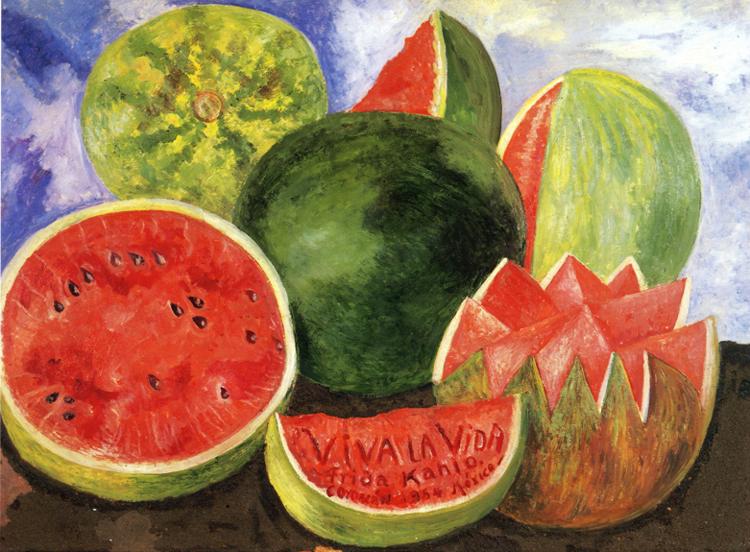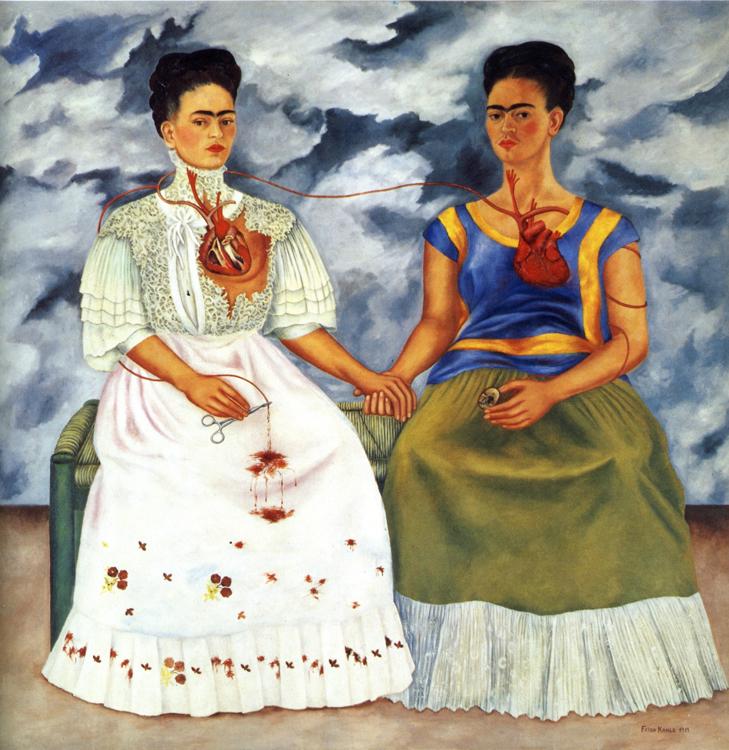Monday, October 26, 2009
Skating and Logismoi
So how does one incorporate a talk on logismoi into one's planned talk on the end times? According to my husband's account, Fr. Dmitri is a student of eschatology, but he is moving away from prioritizing the knowledge of specifics about the future. Logismoi are thoughts that our undisciplined brain incessantly chatters which make us worry about the past and the future. A result of the fall is that we are unable to dwell in the present. He very much recommends Archimandrite Meletios Webber's book, Bread & Water, Wine & Oil, An Orthodox Christian Experience of God, to find out how to dwell in the present so that one need not unduly worry about Christ's Second Coming.
I find it much easier to work out on the elliptical exercise machine while watching figure skating, especially engaging figure skating such as Olympic hopefuls Davis and White from the USA and Virtue and Moir from Canada are able to deliver. Usually I am more attentive to the single skaters, but this year these two ice dancing teams are able to translate moving arms and legs into a transcendental experience that I can't describe. This routine won the Canadians the gold in France weekend before last:
Virtue and Moir
(Sorry, I haven't yet figured out how to post youtube videos on blogger yet.) The routine that won the United States the gold in Moscow this past weekend apparently hasn't been posted yet, but this one's pretty good:
Davis and White
I can't predict which one will win the Olympics as they didn't compete against each other during these events. I'd be happy for both North American teams.
Tuesday, October 20, 2009
A Dream is a Wish Your Heart Makes
-Kierkegaard, Fear and Trembling
I've read this quote about five times and believe at this point that he's making a distinction between faith and wishing. Wishing is an immediate instinct of the heart and faith is not. A young girl following her heart is lovable, but not faithful. What could one learn from her then? To not be a nihilistic materialist or a pessimistic intellectual. But one cannot learn from her how to achieve union with God. Her wishes can't come true and she must face this. This resignation is death to her, and she cannot fathom committing suicide. Of letting her heart stop. But without doing so, she will not reach her end. She will remain a fat caterpillar instead of becoming the beautiful, soaring butterfly she was meant to be. 'Be still and know that I am God.'
Wednesday, October 14, 2009
Just Breathe
With my low blood sugar, it can seem like an impossible task to just get up and make my protein shake and vitamins. This is sort of like medication because without it, I can hardly function. When my blood sugar is low I am also in a very low-willing state. I don't really want to function when it's like that. But something inside propels me amidst my lack of will to get up and take my medicine. It's then that the voice of my children bring a spark of vitality to me. Before my shake their noises remind me that I have no strength, but after, interacting with them is a source of joy. There is something in me that is stronger than me that wont give up, except for that one time. I wouldn't say it's a will to live, but that it is part of being human to keep doing stuff that contributes to life. We can't help ourselves.
One time I heard the Saturday Night Live comedienne, Julia Sweeney, talk about her brother's last moments. His body had given out due to cancer, but he was having trouble letting go. They had to call in a death therapist who talked him through it. At the end of the session she told him to imagine that he was on a trampoline jumping up... and down... up... and down... up... and down, and now imagine jumping off.... and he died. I've always felt that one has to, except in cases of devastating trauma, voluntarily let go of life. That otherwise one can always force oneself to breathe one more breath. Ms. Sweeney's story gives some credence to that.
Right now as long as today is today, I can keep breathing. It may be almost all I feel I can do sometimes, but it is enough to allow me to pray,
Sveti Boge, Sveti Krepki, Sveti Bessmertniy, Pumiluy nos.
Slava Ottsu, i Sinu, i Svetomo Duhu
| i | nynje | i | prisnw | i | vo | vjeki | vjekwv" | amin' |
I found a new pronunciation page for Slavonic prayers. I put it with the others I mentioned recently in a new link category, Slavonic helps.
Wednesday, October 7, 2009
That which must be unsung
But I wont vilify electronic pixels, radio transmissions, and fluorescent lights. They still illumine content. We can still connect with the content. It's just a more gnostic connection, and we do have an invisible intangible element to us. Electronic warmth is still warmth. It is more efficiently transmitted across space and time. The content may not warm us as much or as long, but any warmth is more than nothing. Not that people before these devices weren't warmed. Perhaps they went outside and felt the sun, smelled the earth, and beheld the green leaves more for that necessary warmth. But today most of us can't buy food and shelter if we spend the necessary time doing that for our health. We are imprisoned by our technology, and instead subsist on its paler light. But there is still a person on the other end of that dim light. And that person can warm you with content about God, love, and Orthodoxy so that when you do go outside or to Church, your senses can be more informed. Maybe it's not best, but it's what some of us do.
Monday, October 5, 2009
Zombieland
Nerd guy uses boyscout type rules to survive the zombies. He critically analyzes each situation and applies the appropriate rule, then continues his search for a zombieless place. He is the reluctant warrior.
Tough guy kills zombies as catharsis. He's angry and he takes it out on the zombies. Nerd guy realizes that he must let tough guy vent (another addition to his list of rules), or he'll get it aimed at him. I still say he's dispassionate or apathetic about the zombies. He seems to care less about them, he's just using them as opportunities to vent.
Pretty girl long ago realized that anything is permitted in her independent quest for her sister's and her own survival. Instead of destroying things, she leaves them behind.
Little sister is along for the ride and trusts big sister. Sort of like nerd guy.
All are searching for a zombieless place when they meet. The developing relationships between them are worth the gore.
But if tough guy needs something to violently vent at, what would he do if he found a zombieless place? I suppose he would seek a more positive thing to replace that which made him upset in the first place. If he didn't have the zombies though, would he have gotten over the loss and been able to move on?
Nerd guy, with his seeming calm, had previously been immersed in a video game, so his calm could be attributed to the catharsis of virtually killing things in World of War Craft.
Catharsis is set up to be that which enables a person to purge the effects of negative things in their lives. Depression seems to be what happens when those negative effects are kept inside. Healing is seen to take place when a person is able to verbalize their pain, but sometimes a physical action is seen to be helpful too. Is it relative? I have heard that watching Saving Private Ryan was cathartic to veterans of WWII who had never told anyone of the horrors of war. They had kept it in their whole lives. Having the story told by someone else made them cry. Perhaps they took the nobler course. The course of those who patiently wait and then relief comes finally from another source.
But is it possible to be affect-less when painful things are inside? I believe there is a problem of rage and depression in the WWII generation. This has had a cultural effect that could explain the baby boomers of the '60's and my generation, generation X. Not to be too reductionist, but I believe that many of these men, not just the veterans but the ones who were a bit older and younger than they, took out their rage at home, and many of the women superficially dealt with it by denying it which caused them not to relate realistically to others, including their kids. There are other extenuating circumstances, but in talking to my peers, I have noticed similar dysfunction in their families, and one psychologist has written a book about the family dynamics of that generation. I haven't read this book, but a client of his told me some basic things, not all of the nature that I related above.
But if one is killing things virtually, in video games and in stories, isn't one participating in the act to some extent? Plato seems to believe this, and that it contributes to unhealthy passion in one's own life. He concedes though that since there is an innate charm to stories, that it's okay if one doesn't let ones self validate the vicarious experience. I take this to mean that one should not wish revenge and destruction to be had on any real people or things. Perhaps then one can be relieved at the cessation of the causes of pain by attributing the cause to spiritual forces such as demons. It is easy to imagine that the zombies are demons, and that the person they took over is essentially gone. And are we not to be ruthless with demons? The nerd guy even says to one of the newly turned zombies that he realizes that they are sick and that their zombie insatiable cannibalistic behavior is not something that they would normally do. Yet they have to be stopped. The question of self-preservation is brought up, and based on the premise in the movie, it is pointless to sacrifice ones self for the zombie because that person has ceased to exist and if they have their way with you now, you will be forced to become a zombie yourself and perpetuate the illness. Resistance is the only option.
This raises the question of giving up on people. If we look to history, it seems that certain people had to be stopped and that they were not going to repent but continue on a path that would destroy all in their wake. The people who have stopped these destructive people are considered heroes. There are also instances where people have been vilified and destroyed wrongfully. Nowadays people are questioning who were the villains and who were the heroes and coming up with conflicting answers. I suppose people have always disagreed on this, but there is a consensus about Hitler especially that dominates thinking. All of us have to choose what we will allow near our lives and those of the ones we love. These choices are often painful. And what about if someone else has drawn a line between you? Then what to do with the pain? Nice people don't want to hurt others, so do they sock a pillow, go shopping, eat a tub of ice cream, pelt someone in an online forum debate, watch Zombieland, take it out on family members or gossip in a way that makes them temporarily feel better? Is it really possible to hold it in without one of these or another choice of outlets? I think we all engage in these from time to time. This probably makes up a lot of the content of our guilt and confessions to our priest.
Another choice is to escape it all in beautiful things. But we can't seem to escape for very long. Still, I think it is important to get away from the cycle and look at something beautiful in silence or in peace.
But it is likely we will also watch or read something where catharsis is taking place. Perhaps we can grieve and have compassion on the pain of our times that tempts us, if that is how we are going to categorize the reaction, to participate in it. Lord have mercy.
Henry Poole is Here
Henry Poole is Here stars Luke Wilson, brother of Owen Wilson, as a terminally ill man who is trying to resolve his life by moving back into the neighborhood where he grew up. His Catholic new neighbor notices that the new paint job to his house has left a stain that she thinks is the face of God. He is not a believer, and her persistence with venerating his exterior wall causes a lot of the tension in the movie.
****
The mini bio at imdb quotes Luke as saying,
[On his quirks]: I have this weird thing where I feel exhilarated when I cast things off in my life. Let things go. Even things that are important to me. Sometimes I know I’m making the wrong decision, but I do it anyway. Like, I just lost this watch that really meant a lot to me. I bought it after Bottle Rocket (1996). The first nice thing I ever bought for myself and I lost it. Yet I have this feeling of being glad it’s gone. I don’t know why.
At the end of the movie, when it seems his character is getting something he wants, I was disappointed that I didn’t sense that it was really what he wanted. I think he was supposed to be happy with it, but after reading the above and another quote about how Luke himself handles relationships, I think he really struggles with this. I believe Chris McCandless would relate.
Perhaps it comes from feeling deprived of something necessary, then dreaming about something that should replace it, attaining the new thing and then feeling empty. After deciding that no earthly thing can fill the void or ease the longing, a period of anti-materialism and detatchment can ensue. Like Luke said at the end of the bio page, I don’t think this is depression. Maybe it’s seeing that earthly things don’t satisfy our deepest longings, and gaining a sense that giving things up is the way towards attaining something higher, as Plato might say.
Wednesday, September 30, 2009
Four feeble attempts at levity
If there are fifty-two weeks in a year, how many strongs are there?
One hundred and seventy-nine blind men go into a crowded bar and then can’t find a place to sit.
If fifteen days is half a month, and six months is half a year, how many years are worth halving?
Falling in love is like falling into a river, but you’re happier about it for some reason.
Friday, September 11, 2009
Thoughts and Things
Words, words, words 3
Yesterday at the Church picnic I was asked what comes before and after "Words, words, words" in Hamlet. I remembered Hamlet's frustration with words, but not the exact context. So today I reread that part of the scene and it gives me more questions than answers about words and mental turmoil. I am also thinking of similarities between Chris McCandless and Hamlet. By the way, the movie Into the Wild either chronicles Chris' poetry or poetically speculates the nature of Chris' thoughts, which I find similar to Hamlet's, or at least springing from a similar source. Chris deals with the turmoil differently though (see again the warning in the last post about it being rated R. I wish I'd known the number of scenes to fast forward so that I would have kept the remote more handy).
Back to Hamlet, I am intrigued by this statement,
HAMLET Slanders, sir: for the satirical rogue says here
that old men have grey beards, that their faces are
wrinkled, their eyes purging thick amber and
plum-tree gum and that they have a plentiful lack of
wit, together with most weak hams: all which, sir,
though I most powerfully and potently believe, yet
I hold it not honesty to have it thus set down, for
yourself, sir, should be old as I am, if like a crab
you could go backward.
I suppose Hamlet is leveling the playing field. He is worried about slandering his elders, but is denying that decrepit age makes them above the law.
I also found some interesting and concise interpretations of Hamlet here. I like this one by Professor Ross the best, even though the feminist and post-modern ones also intrigue me. Lord have mercy.
Frida Kahlo
Last night George and I spent a few hours learning about Frida Kahlo, a Mexican surrealist/realist painter. I do not want to judge her morality here (which was similar to the Bohemian artists and writers of the 1920's), and instead want to think about this aspect of her life,
On September 17, 1925, Kahlo was riding in a bus when the vehicle collided with a trolley car. She suffered serious injuries in the accident, including a broken spinal column, a broken collarbone, broken ribs, a broken pelvis, eleven fractures in her right leg, a crushed and dislocated right foot, and a dislocated shoulder. An iron handrail pierced her abdomen and her uterus, which seriously damaged her reproductive ability.
Although she recovered from her injuries and eventually regained her ability to walk, she was plagued by relapses of extreme pain for the remainder of her life. The pain was intense and often left her confined to a hospital or bedridden for months at a time. She underwent as many as thirty-five operations as a result of the accident, mainly on her back, her right leg and her right foot.
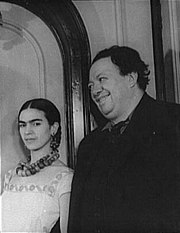
Frida Kahlo with Diego Rivera in 1932, by Carl Van Vechten.
After the accident, Kahlo turned her attention away from the study of medicine to begin a full-time painting career. The accident left her in a great deal of pain while she recovered in a full body cast; she painted to occupy her time during her temporary state of immobilization. Her self-portraits became a dominant part of her life when she was immobile for three months after her accident. Kahlo once said, "I paint myself because I am often alone and I am the subject I know best." Her mother had a special easel made for her so she could paint in bed, and her father lent her his box of oil paints and some brushes.[8]
Drawing on personal experiences, including her marriage, her miscarriages, and her numerous operations, Kahlo's works often are characterized by their stark portrayals of pain. Of her 143 paintings, 55 are self-portraits which often incorporate symbolic portrayals of physical and psychological wounds. She insisted, "I never painted dreams. I painted my own reality." (from Wikipedia, bold mine)
I am drawn to stories about pain, probably since my accident when I was 12 which left me immobilized in the hospital for almost a month, not to mention other heartbreaks including divorce, miscarriage and a still-birth. I find Frida's portraits refreshingly honest. She has been criticized for being self-absorbed, but I am satisfied with her reasoning given above. There is also a certain morbidity about her paintings. I can't completely say that she despaired, though there are statements that would point to that, but there are other evidences that she did not stay in that frame of mind. Her last painting of watermelons bears the caption, Viva la Vida.
The Ochlophobist's 'book club' suggestion, Orthodox Thinking on Theosis, has the title "Self-Transcendence" in the "contents". On the surface (I'm looking forward to reading what Mr. Russell says about it), I can interpret this title to promote a dialectical relationship with the idea of self, where one loses ones self. We can rest in the attitudes suggested in the Orthodox prayers, which can have a self-negating posture, but I think if we were to count the number of "I" pronouns in the Psalms, and even in many of the other prayers, penitential though they be, there would be a lot of them. We are to be honest about ourselves, not totally forgetting ourselves and our lives. Monastics tend to try to forget their past life, and make a complete break with it. They take on a completely new name, part with their possessions and heirlooms, and do not wish to be asked about their past before the monastery, after a certain period anyway. Probably the later vows. Frida painted a dialectical relationship with her self, not of negation by any means, but one that showed how her husband Diego saw her, the Frida he liked, and the Frida he didn't.
This was her perception of how he saw her anyway. I suppose that is what Frida did best, she painted her perceptions from her point of view. I don't want to invalidate this. She struggled to not be consumed by her pain. She struggled very long and intensely. She neither denied it, nor let it completely blind her to the beauty in the world, though she was blinded to beauty immediately after her accident. She said at that time that there was nothing beyond the ugliness of the world, and if there was she would be able to see it. She didn't stay there though. Maybe that's why she was spared, she learned to see the beauty again, even in herself. Her self-portraits can be pretty harsh, but there is a certain acknowledgment of the divine spark, a certain retained comeliness of form.
One painting in particular describes external, imposed pain pretty well, as do the ones of her miscarriages. [I've removed it here, but if you click on one of the other paintings it will take you to her gallery, which can be graphic]
I can't help but be reminded of the cross and the cup of suffering that our Lord accepted. Frida was not ignorant of Christ's sufferings, even though she rejected the Catholicism of her upbringing. Her exposure to Mexican religious art also influenced her paintings.
Perhaps though, when one has suffered, it is easy to get caught up in a persecution/Messiah complex. On one hand this can draw one to Christ, who also suffered, but it is probably easy to slip into the delusion that one is innocent, sinless, and undeserving, or worse, Divine, as He. I sort of like people with Messiah complexes though because they can try harder to act like Christ, with whom they identify. Frida built a garden of Eden out of the home of her childhood, and gave art classes there, Bohemian though they were. But we are not sinless. We can't be naked in the garden. Should she have been so naked in her sufferings as well? One thing being in the hospital does, is that it strips you naked. Indeed even during the bus collision, all of her clothes were torn away and she lay naked and impaled on the ground. During surgery one is stripped bare, and in recovery, there are those stupid gowns, barely on, which the staff draws back with too-familiar ease and entitlement. Necessary evil?
How can one pretend modesty after that? Once one has been involuntarily exposed to the world, what's the use of covering up? If I had had complete control of who to trust to expose myself to, the list would have included two people only. As an infant, a trusted child care provider, who loved me, and then no one until the husband of my choice who would also deliver my baby. To keep that list so short, should I risk my and my babies' lives? I'm going to leave the door open on that one. If they had been the only two, I probably wouldn't be blogging. But since there have been many breaches of protection of my privacy, I want to take control of the information I suppose. That's what Farah Fawcett did when she was diagnosed with cancer. Since the National Enquirer told it wrong, she decided to tell it and produced her own documentary chronicling the last few years of her life and her struggle. I'm glad for her and Frida's sharing of their pain. Frida said that she felt we are all united. When one expresses ones self openly, one is voluntarily inviting a certain type of communion. Oh yes, it was related in the PBS documentary that Frida became communist because of a mistaken idea that it would bring about community, where she wouldn't be alone in her suffering. I'm going to cut her and Farah some slack and pray for mercy on their souls.
If only Chris McCandless could have met Fr. Seraphim Rose
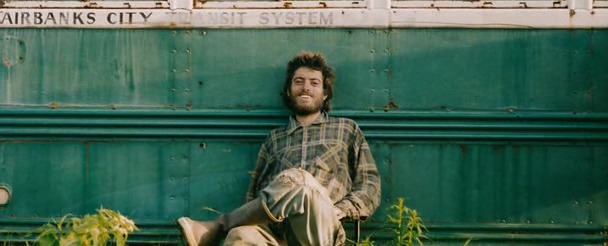
He headed to the Alaskan wilderness as an extreme ascetic forsaking money, companionship, and the comforts of "civilization". In his light backpack however, he brought along Tolstoy, Thoreau, and Dr. Zhivago. Sean Penn made a movie about Chris McCandless called Into the Wild (which is rated R for occasional language and about 3 nudist scenes), based on the book by John Krakaur. Mr. Krakaur's original essay about the innocent is available, but don't click on it if you don't want the ending given away. Incidentally, the author makes a comparison to 5th and 6th century Irish monks who tried to escape civilization in Iceland, then Greenland.
Weekend Happenings
Friday the kids and I went to Church to peel, cube, and boil 100 lbs of potatoes, which were then mixed with cheese, and scooped into little balls, with around 14 people.
The kids brought home some of their friends and we finally beat the 4-player N-64 Tetris game which was begun 10 years ago. The last of the seven wonders was St. Basil's Cathedral! That was cool. Then we watched Tommy Boy, which I'd never seen all the way through before. We had to fast-forward more parts than the kids remembered. The deer scene brought back the trauma I experienced earlier this summer.
[youtube=http://www.youtube.com/watch?v=XiG4SGByY-8]
[youtube=http://www.youtube.com/watch?v=Z1lBAjxDrmo&feature=related]
Saturday morning we went back to Church, rolled out pie dough, ran it through the pasta machine and cut it into discs which were then pinched around the potato cheese filling. A team effort of about 25 people produced 195 dozen Peroghi! One more work day and we'll have enough for our annual Christmas bake sale.
So with all that, Vespers, Liturgy, and Half Priced books (just jr. fiction), and returning #2 son to UD (and the friends to their home), I've had a pretty full weekend.
There Will Be Blood
This past weekend the older ones watched There Will Be Blood with George and I. The credits revealed that it is based on Upton Sinclair's novel, Oil. Wikipedia reveals that the movie is only very loosely based on the book, and that the screen writer only admits to basing it on the first hundred or so pages. I had drawn all sorts of conclusions about Mr. Sinclair watching the movie, but now I have to mix them in with the producers of the movie, as well as my own personal experience and opinions and those of others.
I have read a few critiques from Orthodox bloggers recently on materialistic or scientific cause and effect. Probably much of "secular" psychology is based on it. I have said before that I'm a bit Freudian in my analyses of people, but I think I need to clarify that by relating it to the idea of cause and effect of childhood relationships with family and other influential people, rather than on erotic tendencies. There Will Be Blood is pretty heavy on scientific cause and effect, to every action there is an equal and opposite reaction, theory, mainly in the relationship between fathers and sons. I appreciated the depth of thought and the acknowledgment of how we treat others will affect them, unto the next generations, but the effects were too mechanical, too copy cat. While we may build up steam after being traumatized, and explode on others to a similar degree, I think our reactions are a little more varied, taking into account other influences in our lives, than how they were portrayed in this movie.
Also, there were no efforts towards forgiveness. People seemed unable to control their reactions, and had no other options presented to them, especially not by the cooky churchpeople, who sang a hymn I know and still believe in, "Take it to the Lord in Prayer". However, it did acknowledge complexity in people, such as what to do with inconsistent behavior in parents. The little boy in the movie is portrayed as having the most excusable actions. I imagine that he represents Mr. Sinclair and the screen play writer. We always imagine ourselves the protagonist. But sometimes, maybe we are. The boy has to deal with his greedy, cruel, alcoholic father, who also pays him a lot of positive attention. But the boy knows something isn't right, you can see it in his face, even though he barely speaks throughout the whole movie. When he feels he is being replaced by a long, lost half-brother, he becomes jealous and tries to burn the guy and the stuff that connects him to his father - but there's something not right between his father and the brother, too. When he kicks and hits his father after he was abandoned to a boarding school, his father deserved it, truly. He had been used and replaced. Towards the end, I believe that the son is sincere and correct in being grateful that he had learned a trade from his father, but that it was time for him to move on to start his own business, deliberately out of his father's territory. But his father was paranoid about competition and abandonment and abused him. The son kept his cool and his dignity and rightly walked out of the room. But he did get a pretty good barb in on his way out. The barb had to do with not wanting to be biologically related to his father. That went too far, I thought. I don't think that biological relation has to carry with it the sins of the father. It may predispose one to certain temptations, but I think they can be overcome and the bloodline redeemed. The movie was too fatalistic in presenting effects from influential causes.
There were a few bones throne to the father. Apparently his father, the grandfather, had a mistress, and reading between the lines, he was raised in poverty and probably was not treated very well. I get this mainly from how he sleeps on the floor.
Other than that, the experimental soundtrack noise was quite irksome. The cinematography was really good, and conveyed a tactile sense of being connected to the thentofore unaltered earth. Daniel Day Lewis is a phenomenal actor in everything I've seen him in, beginning with "My Left Foot".
Wikipedia talks about Mr. Sinclair's political activism and socialism. He vilified capitalism, which is very evident in the movie. I recognize abuses caused by greedy profiteering, but I do not idealize the opposite ideology. Any ideologue can be abusive. Wikipedia also says that the book focuses more on the son than the father. I think I'll put it on my very long Amazon wish-list.
Who'd have thought?
The Hills Are Alive
It was over 100 degrees, as it has been for days and days, when Maxim, three of the kids and I drove the scenic route to Kendalia, via Comfort. The hills were brown, but the valleys were holding on to green for dear life. I wonder if the pecan grove was irrigated, or if the stream along side it keeps the deep roots watered. As uncomfortable as the heat is, and wishing that things weren't so parched, including the driest Paluxy River I've ever seen (though this condition enabled us to see the dinosaur tracks better), I do not find reason to despair. 'The grass withers and the flower fades, but the word of God lasts forever', and so do the hills and the rocks. Forever means in the lifetimes of trees and anyone else I know (except the dinosaurs). These hills have been there since I found Jesus at camp in Comfort when I was 15. I've tried twice on my way to Kendalia to drive by that camp, but it always takes longer than I think, and I don't get passed the triangle of highways at Comfort's entrance because either the burial service or Vespers is about to start at the Monastery. I don't despair at this either. Just getting to the edges assures me that it was not all a dream. The hills are still there even though much of the grass isn't.
As it turns out Vespers wasn't served Monday evening because of construction at the Monastery in preparation for a Bishop visit. So we walked down to the dried up creek and began to climb the hills on the other side, the dry grass noisily cracking under our shoes. Shortly, the girls said their Vespers shoes were hurting their feet. I wore tennis shoes with my dress and wanted to keep going over the next hill in the heat, but I had to turn back. Poor me, the tragedian. When we got back the girls made friends with another visiting girl between their ages and had a good time talking to her and teaching her to knit till it was time to visit Jamie and head back home. People first, hills around highways, camps, and monasteries second, I suppose.
(p.s. the video at the above link shows how the Paluxy normally looks.)
Holy Archangels and St. Peter the Aleut Summer Camp
I was at Holy Archangels Monastery in Kendalia two Saturdays ago visiting little Jamie's resting place with his family. I loved being there and feeling the peace at his graveside. It was palpable, quiet, and still.
It was not so peaceful on the way back when I hit a deer. Thankfully no one but the deer was hurt, except for my car which is still in the shop. The rental car is a Kia Rondo, which has a bigger hatchback area than my Matrix. Monday, I and a few of the kids will return to the Monastery in the Rondo with our dear blog friend, Maxim, who's coming down for a visit. Please pray that he'll have a peaceful time with no traumatic run-ins with the wildlife.
On another note, our two eligible kids had a very fun time at the annual St. Peter the Aleut Camp at the YMCA facility at near-by Possum Kingdom Lake last week. I went ahead and had Jordan drive my damaged Matrix to camp two Mondays ago since there wasn't time to get the damage assessed before then, while I drove his car. My door wouldn't open and he is sprier than me at crawling over the middle console. When we picked the kids up from camp last Friday I had a Mitsubishi Galant (due to last week's limited availability of cars in our price range), which was nice, but too low to the ground. The cheaper Rondo's seats are much higher and easier to get into.
Jamie's Priest, Father John from the new mission in Tyler (he gave the homily, "The Kingdom of Heaven Belongs to Such as These" on the header above), and his two kids came to camp this year, as did Father Seraphim with his son from the ROCOR Church in Dallas, and the two returning Priests, Father John with his Matushka Lydia from Dallas, and Fr. Antonio from Pharr. Matushka Patricia, Father John Whiteford's wife, also brought a carload of kids from Houston and was one of the counselors, as were a few other parents, Fr. Antonio's older daughters, and another friend of my boys. The kids love getting together with other Orthodox from around mostly Texas every year for services, talks, and the many fun activities. It's rare for them to have 50 Orthodox peers. We also enjoyed having a house full of campers as well as Fr. Antonio the weekends before and after camp.
Our Trip to Colorado
I would like to write about this past week in one post even though the more organized part of me could compartmentalize the different elements and themes into several different posts, or at least do a chronological, journal type series. Instead I am inspired by the haphazard cataclysm of the Rockies to just throw it all together and let the dramatic diagonal strata be exposed for what they are. The resultant dust will either settle or be washed downstream, but it will not disappear.
Above the strata, dust, flora and fauna stand my husband and children. Now that number one son is approaching 21, and does not really like road trips, he was left behind to take care of the subterranean homestead and the omni-terrestrial Church services. The homestead is subterranean because before the flood, the ground it now stands upon was buried. Texas is part of the great drainage system east of the Great Divide, which we crossed. I would like to read Bill Bryson's Short History of Nearly Everything to be better informed, but barely south of my house is a famous deposit of dinosaur tracks that they say are embedded in what used to be the Texas coast. If that is so, since then more deposits of dirt have extended it perhaps through the great explosions of Yellowstone volcanoes. This must have been pre-flood, because since then layers of sediment have solidified, and great tracks of it washed away by the Flood and subsequent rains, leaving too flat valleys for any other explanation between fingered, stratified ridges. At least west of the Dallas Fort Worth metroplex where I live. East of here is more flat, but greener as the drainage becomes more concentrated. These ridges, plains, and valleys make a gradual, leveling ascent to the great plains in the Texas panhandle. Palo Duro Canyon, 30 miles south of Amarillo, reveals a not too modest crack in the high plains with beautiful layers, especially the red sandstone which makes the Red River, which separates us from Oklahoma, red.
Number two son did not play in the canyon with the rest of us because he was completing his nine days at the Gunnison, Colorado Observatory. His physics group won a grant to travel there to set up new equipment to confirm the existence of planets in other solar systems. It took a few days to calibrate the equipment, and then just when they were ready, rain and clouds prevented any observations through the telescopes for the rest of his time. Before the rain though, Jared saw the milkiest Milky Way he had ever seen through his contact lensed eyes. They still had work to do with some sort of calculations, and additionally had fun scoping out the area with his comrades before we arrived to pick him up. This made him an excellent restaurant and hiking guide for us. We did not get to meet his classmates because google maps plotted the wrong directions to the observatory. We spent an hour driving around in the beautiful mountains south of Gunnison while his friends said good-bye and packed up. One of them let him copy her trip pictures onto his flash drive, so at least we got to see them that way.
After picking Jared up from his hotel, we spent a day hiking around Gunnison and Crested Butte. By then the rain had cleared and the temperature warmed a bit. I am amazed at how warm 60 degrees feels at 12,000 feet. That night we had delicious local pizza and told Jared about recent events, obliquely referred to in my post the beginning of the week before. The heaviness has not gone, but was more easily born at higher elevations in the thinner air and almost overwhelming surroundings. In our winter trip through the Appalachians, which was preceded by a lets-ignore-everything reunion, the surroundings completely absorbed my attention. The more dramatic Rockies were not able to drown everything out. Though they did quiet them a good bit. The Rockies were loud enough, however, to distract me from The Man Who Was Thursday, by G.K. Chesteron. We had gone through the first 60 pages in the Texas plains, which accommodate audible.com embellishment. The Rockies wouldn't have it. This way Jared had time to catch up on those 60 pages, as I had also brought the book and was reading along to help my concentration, which has been very scattered since last week. We all, except for Rebecca who had other things to do, listened together for the remaining five hours after Amarillo coming home. We had about half an hour to discuss it for the remainder of the drive. We didn't like some of the dualistic/ying yang theology nor the Alice in Wonderland type ending (see Aaron's clarifying comment), but thought the characters were pretty intelligently done. The initial confrontations were very engaging, but I thought some of the revelations disappointing. He paid homage to women at the very beginning and ending of the story with what I guess is a Beatrice-type allusion. This balances out his emphasis on and justification for the war-like actions of men, not that I agree with the nature of these balances or justifications. All of this can slightly be spun in one's own mind regarding spiritual warfare with one's own sins, but the way the God-type character is depicted makes that a very generous stretch. Still, I like the way Chesterton works out his philosophy in fiction, even if I don't agree with it. He made a comment in the preface about the story being written in a play-like manner. I notice this with C.S. Lewis too. There's a lot of cutting to the chase. I like that this story can be read in one trip to Colorado, or rather Amarillo, and back, unlike David Copperfield which was four times longer. But I don't know if I would have liked Lewis or Chesterton to lengthen theirs, nor Dickens to shorten his. They are what they are in the way they are written.
I think I'll post pictures next time.
First-fruits
My first tiny, cute, and as it turns out, sour, strawberry

Two tomatoes on the way!

And the Mother's Day chilies (minus oh so busy at college, Jared. It seemed like a milestone however to get my first remote Mother's day phone call.)
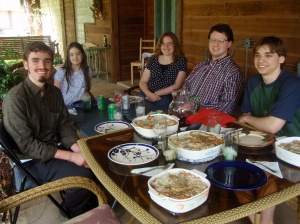
In Memory of Mara
I have not seen my ex-Mother In Law in over 11 years. My children, Ben and Rachel, have not seen her in about 6 years, but yesterday their dad called to say that she had just died after a long illness. She was a very private woman, and the only Catholic in her household. When I knew her I was staunchly Protestant, but I played "Ave Maria" on her antique piano one time and opened my mind to it just a little. She went to Mass pretty often by herself and did not pressure her family to do likewise. She and her husband built a house from scratch in the country and restored antique oak furniture. I very much admired them for that. When her son and I had difficulties, I wanted her to be more active in helping me, but she did not see things the same way I did. Maybe she was right. However, I'm sadder than I expected at her death. Last night Ben chanted this prayer slower than he usually chants, in his lovely bass voice, for his departed Grandmother:
Chosen Intercessor and High Priest, Who hast laid down Thy soul for the salvation of the sinful world and hast given us authority to be children of God, and to dwell in the never-ending day of Thy Kingdom, grant forgiveness and eternal joy to Thy servant who has fallen asleep, for whom we cry to Thee in supplication. Jesus, All-merciful Judge, vouchsafe Thy servant Mara the sweetness of Paradise.
O holy Guardian Angel given by the Lord: Come pray for thy servant, whom thou didst accompany, preserve, and direct on all the paths of life, and cry with us to the All-compassionate Saviour:
Jesus, tear up the handwriting of the sins of Thy servant Mara.
Jesus, heal the wounds of her soul.
Jesus, grant that there not be bitter memories of her on earth.
Jesus, for the sake of this have mercy on those who were grieved and offended by her.
Jesus, cover her imperfections with the radiant garment of Thy redemption.
Jesus, gladden her by Thy loving-kindness.
Jesus, Ineffable, Great and Wondrous- reveal Thyself to her.
Jesus, All-merciful Judge, vouchsafe Thy servant Mara the sweetness of Paradise.
Lazarus Saturday, Remembering Jamie after 40 days
John 11:14 Then Jesus said to them plainly, “Lazarus is dead. 15 And I am glad for your sakes that I was not there, that you may believe. Nevertheless let us go to him.”
16 Then Thomas, who is called the Twin, said to his fellow disciples, “Let us also go, that we may die with Him.”
17 So when Jesus came, He found that he had already been in the tomb four days. 18 Now Bethany was near Jerusalem, about two miles[a] away. 19 And many of the Jews had joined the women around Martha and Mary, to comfort them concerning their brother.
20 Now Martha, as soon as she heard that Jesus was coming, went and met Him, but Mary was sitting in the house. 21 Now Martha said to Jesus, “Lord, if You had been here, my brother would not have died. 22 But even now I know that whatever You ask of God, God will give You.”
23 Jesus said to her, “Your brother will rise again.”
24 Martha said to Him, “I know that he will rise again in the resurrection at the last day.”
25 Jesus said to her, “I am the resurrection and the life. He who believes in Me, though he may die, he shall live. 26 And whoever lives and believes in Me shall never die. Do you believe this?”
27 She said to Him, “Yes, Lord, I believe that You are the Christ, the Son of God, who is to come into the world.”
32 Then, when Mary came where Jesus was, and saw Him, she fell down at His feet, saying to Him, “Lord, if You had been here, my brother would not have died.”
33 Therefore, when Jesus saw her weeping, and the Jews who came with her weeping, He groaned in the spirit and was troubled. 34 And He said, “Where have you laid him?”
They said to Him, “Lord, come and see.”
35 Jesus wept. 36 Then the Jews said, “See how He loved him!”
37 And some of them said, “Could not this Man, who opened the eyes of the blind, also have kept this man from dying?”
38 Then Jesus, again groaning in Himself, came to the tomb. It was a cave, and a stone lay against it. 39 Jesus said, “Take away the stone.”
Martha, the sister of him who was dead, said to Him, “Lord, by this time there is a stench, for he has been dead four days.”
40 Jesus said to her, “Did I not say to you that if you would believe you would see the glory of God?” 41 Then they took away the stone from the place where the dead man was lying.[d] And Jesus lifted up His eyes and said, “Father, I thank You that You have heard Me. 42 And I know that You always hear Me, but because of the people who are standing by I said this, that they may believe that You sent Me.” 43 Now when He had said these things, He cried with a loud voice, “Lazarus, come forth!” 44 And he who had died came out bound hand and foot with graveclothes, and his face was wrapped with a cloth. Jesus said to them, “Loose him, and let him go.” (emphasis mine)
This has always been a confusing story to me. Why would Jesus deliberately take His time? Why did He tarry when He could have prevented Lazarus' death? Just so that people could believe? Belief was more important than saving someone's life, and was worth the emotional roller coaster? It is comforting that Christ was troubled and wept. He enters into our sorrow. Four days. I would have been pretty upset at Jesus by then if He were a close friend and I knew and believed in what He could do. People who lose loved ones even now get mad at God. We know He could have prevented it and very often does for other people.
Some suffer in order to increase their faith. The fact that Lazarus was dead for four days, longer than any other person who had been raised from the dead is significant too. Christ shows that there is no amount of time that is too long to be raised again. Four days is too long for a mother to wait. A whole earthly lifetime is too long to wait to be rejoined with a loved one. Much too long. And Jesus wept for this fact.
I remember the cloth over Jamie's (as well as my son Isaac's) face, and I can't wait, but God defiantly makes us anyway, till it is removed and his body is set free from its confines at Holy Archangel's Ephraimite Greek Orthodox Monastery. Aionia Mneme, Kyrie Eleison. Memory Eternal, Lord have mercy.
Flowers and Lizards
This Purple Shamrock has survived my not-so-green thumb since it was given to me nine years ago when Isaac died. It's a mercy.

This is one of two Bluebonnets that are growing in my yard after a baggie full of seeds from a dear parishoner were broadcast last fall. Bluebonnets can be hard to grow as they're pretty picky about soil. They like Mary's yard and the steep embankments of Texas highways however.

I'm glad to have a couple of indigenous Mesquite trees in my yard as well. I've heard that cows distributed Mesquite pods in Texas during the cattle drives and that they weren't here before then.
This desensitized lizard lives in our backyard.

Lament not for me
After the Panikhida Sunday night I shared with the parents that when my baby died I was not yet Orthodox, and so he did not get to have an Orthodox funeral. I told them I was experiencing this with them, and in many ways it felt like it, though I'm sure the pain is not as acute as it was when the loss was still new in my case. I have been hungry for these services and to know what it was like for them as Orthodox. When my son died I had a confidence that he went to be with the Lord, but the Orthodox services have the clout to back that up and the poetry to express it well.
Father Basil had told us at Church Sunday morning that the funeral service for an infant is different than for an adult because babies are considered Saints since they have not sinned.
One of the monks at the monastery where Jamie is buried said, "It is rare to have a funeral where you have no doubt where the person is."
Here are some excerpts from The Service for the Burial of an Infant (St. John of Damascus Orthodox Mission),
Let us not lament the infant, but rather mourn for ourselves who sin always, that we may be delivered from Gehenna.
Thou hast deprived the infant of earthly delights, O Master. As the Righteous Judge, do Thou count him worthy of heavenly good things.
He hath taken thee from the earth and numbereth thee with the choir of the saints, hath shown thee a citizen of Paradise, O truly blessed infant. (from Ode 4)
"Lament not for me, for I have in no way begun to be meet for weeping, But rather weep always for yourselves who have sinned, O kinsmen and friends," the dead infant cries out, "that, tested you not receive torment." (from Ode 5)
Thou hast deprived Thine infant of earthly good things, that Thou mayest show him a partaker of Thy Heavenly good things, in-asmuch as he has not transgressed Thy divine command. We glorify the boundless depth of Thy judgment, O Good One. (from Ode 6)
With Thy light, o Word, do Thou illumine the face of Thine infant, who, in the Faith, has now been translated unto Thee at an untimely age, and sings unto Thee: O Lord God, blessed art Thou.
Thy parting now appears to be a cause of sorrow unto them that love thee, but for thee, in truth, obtains joy and gladness. For thou, O infant, inheritest eternal life.
Behold my affliction, O Virgin, which the multitude of my evils have brought upon me. And before I depart hence, by thy maternal prayers grant me refreshment, that God may be merciful to me. (from Ode 7)
In his rage the Chaldean tyrant ordered the furnace to be heated sevenfold for the Godly Ones. But having seen them saved by a better might, he cried aloud unto their Maker and Redeemer: You Children, bless; you Priests, sing; you people, highly exalt Him unto all the ages.
Refrain: Give rest to the soul of the infant, O Lord.
May Christ establish thee in the bosom of Abraham, in the abodes of rest, where is the joy of them that ever keep festival, in the places of release where living water is, Who dist become an infant for the sake of us who are crying out unto Him unceasingly: You Priests, sing; you people highly exalt Him unto the ages.
The constant memory of thy parting, in truth, has become for us a cause of sorrows and tears. For before tasting the beautiful things of this life, thou hast departed the earth and the bosom of thy parents. But Abraham's bosom shall receive thee as an infant that had no part in any defilement.
Let us bless the Father, and the Son, and the Holy Spirit, the Lord.
"Why do you mourn me, the infant that has been transplanted hence?" he cries out invisibly, as he lies dead. "For there is no cause for grief. For the joy of the righteous is appointed unto infants who have committed no deeds worthy of tears. For they sing unto Christ: You Priests, sing; you people, highly exalt Him unto the ages!" (from Ode 8 )
O Christ Who dist become an Infant, yet without change; Who, of Thine own will, didst unite Thyself unto the Cross and didst behold the maternal affliction of her that gave Thee birth: Do Thou ease the sadness and cruel grief of the faithful parents of the dead infant, that we may glorify Thy majesty. (from Ode 9)
***
In addition to these comforting words which tell us the state of our dearly departed infant, the Orthodox funeral service speaks to the grief of the mourning loved ones, especially the parents, as Reader David Bryan also brought out today.
No one is more pitiful than a mother,/
and no one is more wretched than a father,
for their inward beings are troubled/
when they send forth their infants before them./
Great is the pain of their hearts because of their children,/
and still more when these are pleasing of speech,/
as they call to remembrance/
their words with the song://
Alleluia.
For often before the grave they beat their breasts and say:/
"O my son, and sweetest child!/
Hearest thou not what thy mother says?/
Behold, also, the womb that bore thee./
Why speakest thou not with us,/
as once thou didst speak?/
But thout art silent/
and speaketh not with us://
Alleluia!"
"O God, God, Who hast summoned me;/
Be Thou the consolation of my household now,/
for a great lamentation has befallen them./
For all have fixed their gaze on me,/
having me as their only-begotten one./
But do Thou, Who wast born of a Virgin Mother,
refresh the inward parts of my mother,/
and bedew the heart of my father with this://
Alleluia!"
***
The burial at Holy Archangels monastery was sad but peaceful, and the monks chanted very gently and sweetly in Greek while the breeze was blowing over us. When they were lowering the casket, a big sustained gust came and my daughter Rachel, and later Jamie's mother remarked that they thought it was a special gift. George just said that when it happened what went through his mind was, "Precious in the sight of the Lord is the death of His Saints."
[edited to include a link to the wonderful Homily given by Fr. John at Jamie's funeral]
The Sunday of Orthodoxy
Today, the Sunday of Orthodoxy, is the fourth anniversary of the reception of my husband, myself, and our six children into the Holy Orthodox Church, the Body of Christ. I believe it is in large part due to the intercessions of our seventh child, Isaac, departed this life shortly before he was born on March 10th, 2000, the same day that Ben was born, but nine years later. When we buried Isaac, we had inscribed in his tombstone, "In His Care". I believe Isaac petitioned the Lord to put us into the care of the Orthodox Church to be nurtured by His Body and Blood.
Today the Church commemorates the Triumph of Orthodoxy in which the Seventh Ecumenical Council proclaimed that the Church is visible and material in the Incarnation of Christ, and that thus holy images of Christ and the Saints may be venerated, held, and kissed as one would love their prototype, as had been done by the Church since Christians departed this life.
Today after Liturgy, before the procession of Holy Icons around the Church commemorating the re-establishment of icons by the Church, there will be a Panikhida, for Baby Jamie (1/2/08 - 3/3/09) at St. Barbara's. After that we will travel to East Texas where we will be reunited with him and his family at the funeral home for another Panikhida.
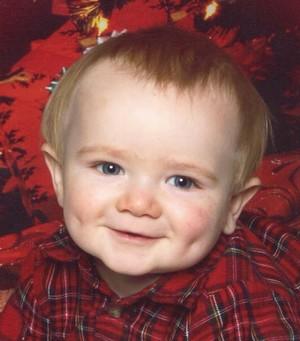
This is what the family shared about him for public release, "'Jamie' was always so happy and active. We will miss his sweet personality, bright blue eyes, and dimpled smile. He brought such joy to our lives and we look forward to our reunion with him, where there will be no more parting.
May his memory be eternal."
Our very dear friends, the Reader Daniel, "Zachary" and Lindsey and their older son, Josh, moved from our parish shortly before Jamie was born and began attending the mission which our blogging friend, John "Terry", from Notes from a Common-place Book helped found. They came back to our parish to have Jamie baptized. That is when I first met John, by the way, as he traveled to St. Barbara's for the occasion. I wrote about that here. They also came back to visit several times during this past year. They were received into the Orthodox Church a few years before we were at St. Barbara's, and so their Godparents are here. In fact, Zach is my son, Jordan's, Godfather and Lindsey is my daughter, Rachel's, Godmother. Jamie's Godfather also attends our parish. Jamie was indeed a very happy, loving baby. He did not seem to have as much separation anxiety as many babies. I had the privilege just a couple of months ago at fellow parishioner and blogger (Oh Taste and See), the Reader David "Bryan's" house to hold him and appreciate his exceptionally sweet nature. The picture above says it all.
Tomorrow morning we will attend his funeral at the mission Church, St. John of Damascus, whose namesake eloquently defended icons in the Seventh Council. Then we will travel to the Holy Archangels in Kendalia, who will care for his body and pray for his soul. Our prayers are with Jamie and his dear, sweet family.In Memory of Baby Jamie, who fell asleep in the Lord 3-3-09
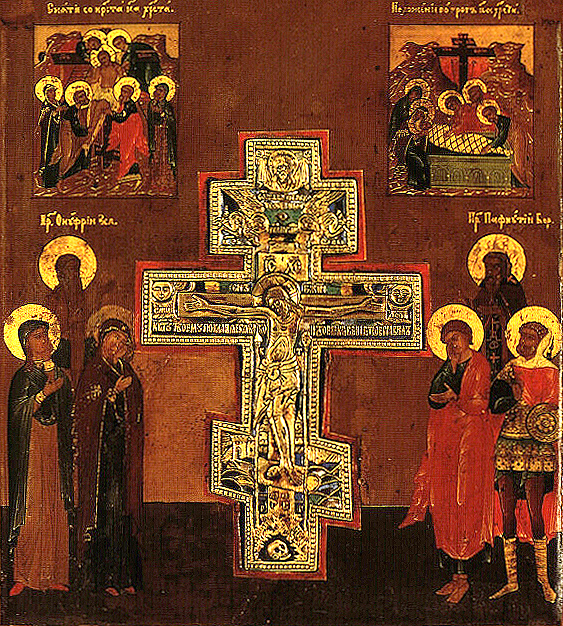
Commemorated on March 6
The Holy Empress Helen uncovered the Precious Cross and Nails of the Lord at Jerusalem in 326.
At the beginning of the reign of St Constantine the Great (306-337), the first Roman emperor to recognize Christianity, he and his pious mother St Helen decided to rebuild the city of Jerusalem. They also planned to build a church on the site of the Lord's suffering and Resurrection, in order to reconsecrate and purify the places connected with the Savior's death and Resurrection from the foul taint of paganism.
The empress Helen journeyed to Jerusalem with a large quantity of gold. St Constantine wrote a letter to Patriarch Macarius I (313-323), requesting him to assist her in every possible way with her task of the restoring the Christian holy places.
After her arrival in Jerusalem, the holy empress Helen began to destroy all the pagan temples and reconsecrate the places which had been defiled by the pagans.
In her quest for the Life-Creating Cross, she questioned several Christians and Jews, but for a long time her search remained unsuccessful. Finally, an elderly Hebrew named Jude told her that the Cross was buried beneath the temple of Venus. St Helen ordered that the pagan temple be demolished, and for the site to be excavated. Soon they found Golgotha and the Lord's Sepulchre. Not far from the spot were three crosses, a board with the inscription written by Pilate (John 19:19), and four nails which had pierced the Lord's Body.
Now the task was to determine on which of the three crosses the Savior had been crucified. Patriarch Macarius saw a dead person being carried to his grave, then he ordered that the dead man be placed upon each cross in turn. When the corpse was placed on the Cross of Christ, he was immediately restored to life. After seeing the raising of the dead man, everyone was convinced that the Life-Creating Cross had been found. With great joy the empress Helen and Patriarch Macarius lifted the Life-Creating Cross and displayed it to all the people standing about. (OCA.org Daily Commemoration)
***
What earthly sweetness remains unmixed with grief? What glory stands immutable on the earth?
All things are but feeble shadows, all things are most deluding dreams,
yet one moment only, and death shall supplant them all.
But in the light of Thy countenance, 0 Christ, and in the sweetness of Thy beauty, give rest to him whom Thou hast chosen,
for as much as Thou lovest mankind.
I weep and lament when I think upon death,
and behold our beauty created in the likeness of God lying in the tomb disfigured, bereft of glory and form.
0 the marvel of it! What is this mystery concerning us? Why have we been delivered to corruption? Why have we been wedded unto death?
Truly, as it is written, by the command of God Who giveth the departed rest.
- St. John of Damascus Funeral Hymns
Memory EternalEggs in Different Baskets

I guess -C inspired me without realizing it. I picked the pattern out of Ukrainian Easter Eggs and How We Make Them after viewing her exquisite Pysanki without remembering she had one very similar. Circular patterns feel more natural to me so I'll probably make more like it. The red one isn't dark enough in that it doesn't contrast enough with the gold, so I either should have left the egg white before drawing the lines, or I should have used a darker red than Scarlet.
The wooden egg behind it is of and from the St. Nicholas Orthodox Church in Juneau, Alaska.
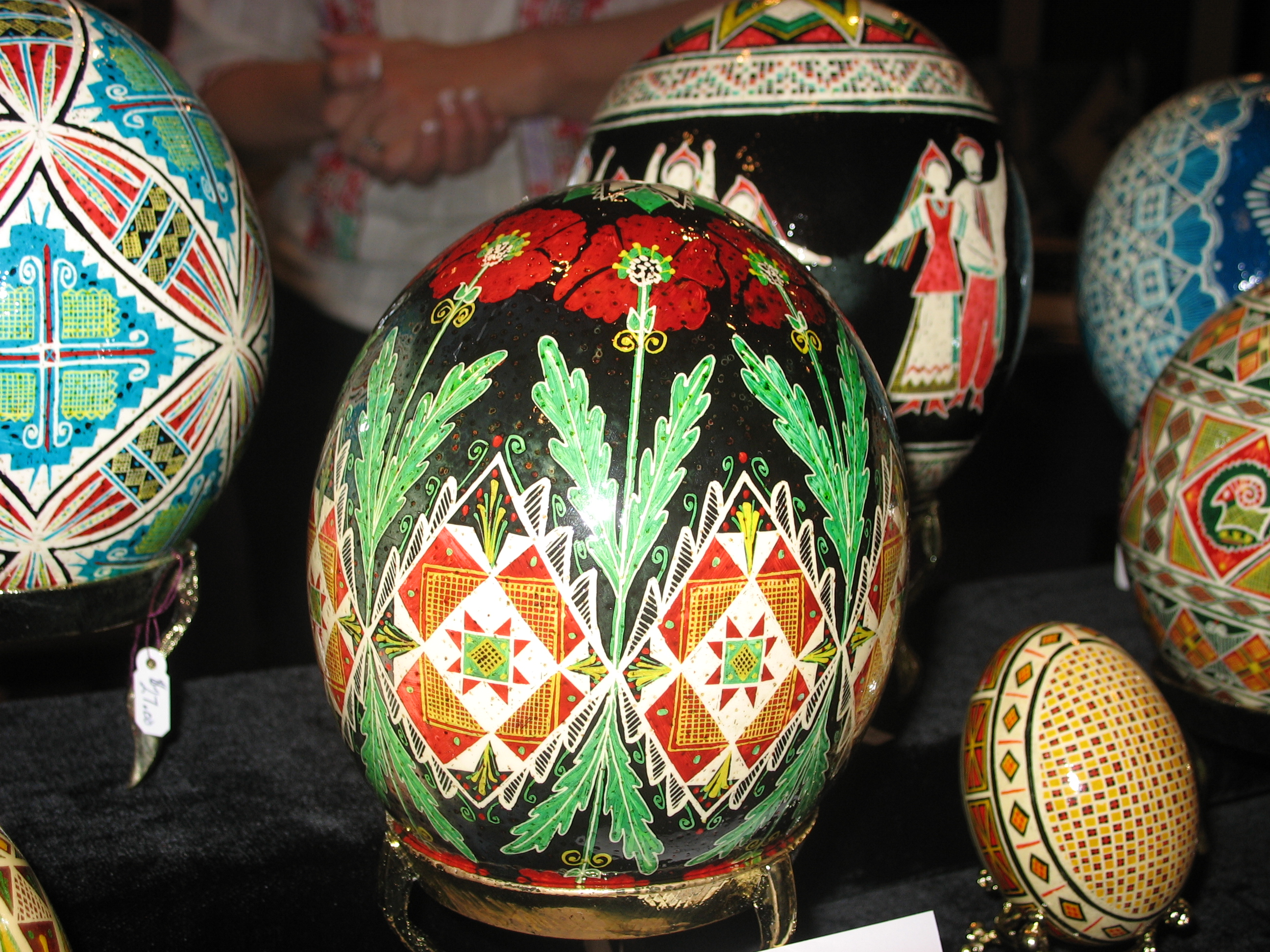
Here are some of the ostrich eggs our authentically Carpatho-Russian Matushka does for the sale. She also teaches classes. See the St. Barbara website to the left for timely details.
Pysanki Lament
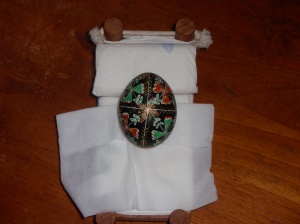
The lines seemed to be working,
The colors, except the green which mottled, seemed pure,
Up until the last, the black, after which,
I dropped it. I dropped it. I green and yellow dropped it.
Forgive me. You can live here, even though you're cracked.
(H/T to Ella Fitzgerald)
Yesterday's Egg
I took pictures between colors so that you could see the process better. This one shows the waxed lines that will end up being the white ones. See how it's counter-intuitive when you're making them? The one on the left is Rachel's. Again, sorry for the blurriness, it apparently focused on the crumbs on the lid.
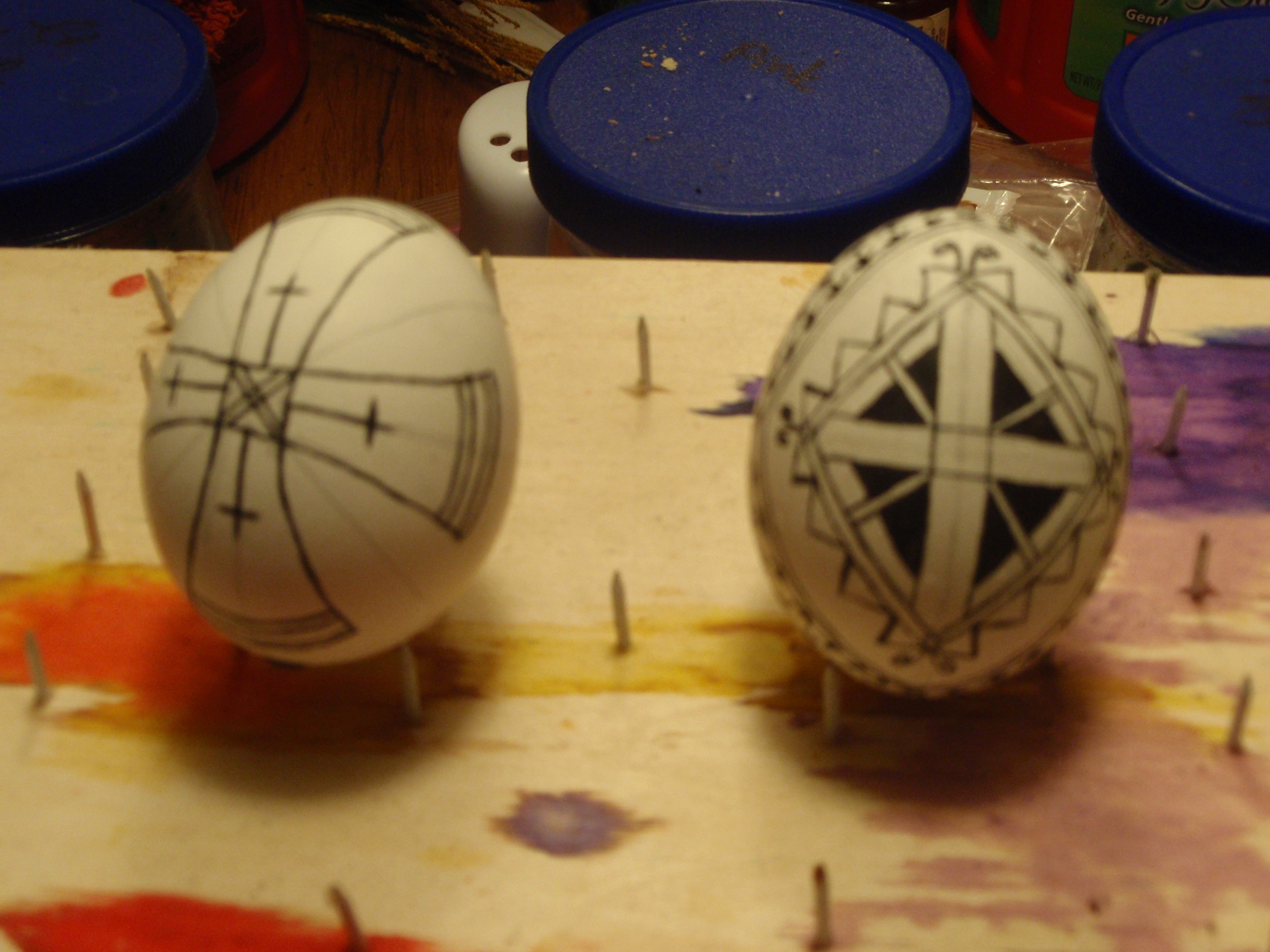
The extra lines in the next one shows what will stay gold. The gold that you see in this picture will not stay that way. I also dabbed in some green with a Q-tip because the next layer of red will not be as bright if I were to dye the whole thing green. I could dip the egg in "orange wash", which is just orange without vinegar, to get rid of the green, but since the green will be so small, it's easier just to dab the few spots.
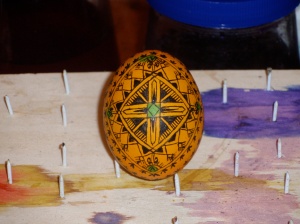
I didn't take an extra picture after I blocked in the green. This next one shows the extra lines and shaded parts that will stay red.
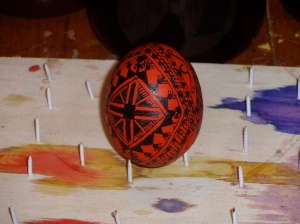
Then it's ready to be dipped in the black. You can kind of distinguish between the black dye and the black wax in this shot. The wax turns black, btw, because of the carbon changes when it's heated on the stylus. The one on the left is Rachel's finished egg, which was dipped in watered down light blue, full strength light blue, and royal blue.

And the finished egg, except for varnish.

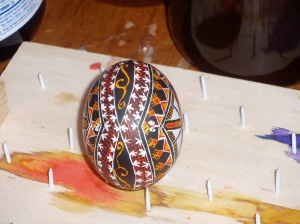
I am not the most geometrically correct pysanki person. It is hard to draw straight lines on a curved surface, and you can't use a straight edge. My kids however are much better at line control than me. Mercifully, somehow the colors make the imperfections not so devastating. I've always been an impressionist anyway. And usually I like to make more organic pysanki of flowers, leaves and such. So far this year I've been practicing more on basic lines, but I'll probably get back to the flowers soon.
Another note on dyes. Our first year we did not buy the packaged dyes, but made our own. Traditionally in Eastern Europe, people would make dyes out of the plants that grew in their region, so each region's pysanki took on a local character in both color and design. We made brown dye out of coffee and blue dye out of blueberries. However, neither the coffee nor the blueberries were grown anywhere near my area. I don't think I have pictures of those eggs which were sold at our Church's annual spring Pysanki sale. You can click on the link for details about this year's sale.
I should have begun by sharing the history of Pysanki, which is mostly a Ukrainian and Carpatho-Russian tradition, and the nature of the symbols used. This site has most of the explanations I've heard about Mary Magdalene and about an egg representing the Resurrection. It also includes this description of how ancient pagan symbols were "baptized" when Christianity reached the region,
There is a whole vocabulary of the symbols which are used to decorate the eggs. Many of the symbols are universal, drawn from nature: the sun and stars, flowers and fruits, leaves and trees, animals, birds and fish. Sometimes the pagan meaning is simply carried over to the Christian use of the symbol, and sometimes a new layer of meaning is added. A fish is an ancient symbol of health and also a symbol of Christ himself. A pine tree represents youth and health, as well as the Christian hope of eternal life. A rooster is a symbol of fertility, and also a reminder of the cock that crowed when Peter denied his Lord. Geometrical symbols are also popular: a triangle represents the human family--father, mother, and child--as well as the Holy Trinity. An egg with forty triangles represents the forty days of Lent. Specifically Christian symbols such as the cross and a church need no interpretation.
It also has some very nice pictures.
Pysanki 2009
I am somewhat behind on my Pysanki making this year. If I commit to one a day I should be able to come up with 26 before they are due. Our family has promised 36 so I hope the kids will be able to take up my slack. Fortunately Spring Break will occur before the due date, so maybe my talented college kids will find the time.
Here's my first four in the order of making them. So far I like #3 the best. I don't know if the blurriness is because of me, the camera, or the computer. They looked focused on the viewfinder, but not when I uploaded them.

These eggs have been cleaned with Charcoal Starter, but they have not yet been varnished, which really makes the colors pop.
There are good explanations of how to make Pysanki available to anyone who will buy a book or do a computer search. Last year I provided a link, but this year I'll try to explain it. The design is created by drawing lines or filling in shapes over the desired color with melted wax. The hardest thing to get used to, is that you create your design in opposite order from light to dark, so that the highlights come first. You start with a white egg that has been blown and cleaned through a drilled hole in the bottom. We use a German made drill and accordion "bellows" connected to a needle. The color will take better if the egg has been rinsed with distilled water and vinegar.
Many people pencil in the egg divisions which are at least horizontal and vertical into 8 parts. Most eggs will start with these 3 lines being covered with wax by using a calligraphy stylus that has been heated in a candle flame, usually beeswax, and loaded from a separate beeswax block. Then the loaded stylus is reheated to melt the wax which for a few seconds will cover the line that is gone over on the egg, before it has to be reheated in the flame. The first egg above shows that I blocked in the cross and the wheat with wax while the egg was still white. Then the egg is usually dipped in yellow, depending on the design. What is desired to stay yellow is then drawn or blocked in. The design becomes increasingly obscured by wax with each layer of color, so the end result will be a complete surprise, but I get ahead of myself. After the yellow is blocked in, the egg is dipped in the next color, which was red in the third egg. After the red was blocked in, that egg was dipped in black. After the last color has taken, the egg is carefully held over the candle, not too long or it could scorch or even explode, and not too short or the wax wont come off cleanly. The wax is wiped off with a Kleenex. All the steps make a tedious process, especially for the non-detail oriented like me, but the unveiling makes it worth it. It usually turns out better than I think because I am aware of mistakes when I am drawing on the wax, but I can't predict how forgiving the colors will be until the wax is removed. But then when one's egg is held next to a truly experienced and skilled pysanki maker's, one is not so impressed with ones self.
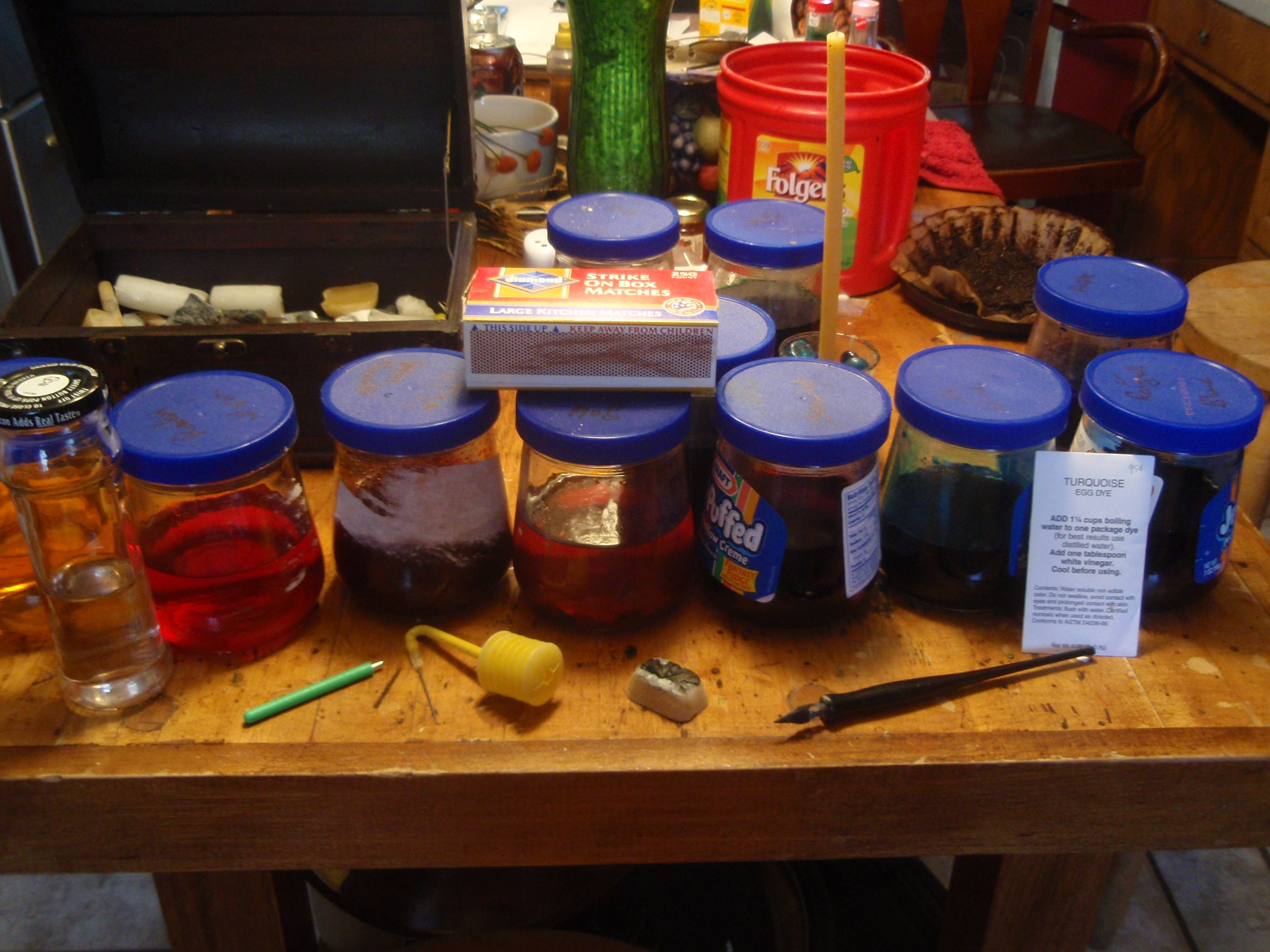
A brief statement about the dyes, they come from the Ukraine, I think, in powdered form in an envelope to be added to 1 1/4 cups of distilled, boiling water. Most also require a tablespoon of vinegar, which can be re-added later if the dye stops taking to the egg. Most of our people use Jet Puff Marshmallow Cream jars as they are a good width to make sure the egg gets covered when dipped. Since the eggs are hollow, they float, so a spice jar is usually placed over it to keep it down for the necessary few minutes until the desired color is achieved. By the way, one must remember to seal the hole at the bottom of the egg with melted wax so that it will not fill up with dye and continuously drip even after you think you've drained it and resealed it. A most frustrating experience.
Like reading books, Pysanki making is a very worthwhile pursuit, but I have to really put my determination hat on to begin every day. Reading and writing blogs takes no such determination, but is like falling off a log. Reading and writing well, now I do have to exert effort to not be totally reckless, which I'm sure I don't apply enough of which to do.
Torchfire Productions
With the college boys home for the holidays, they had time to devote to making another movie. This one's called Red Window. Again, it's easier to see in "higher definition" available on the youtube page as it is filmed at night, albeit a moonful night...
[youtube=http://www.youtube.com/watch?v=4QovXtddrEs]
Monastery pics and Shaping up
I wish I'd taken more pictures on our trip, but I have mixed feelings about taking photos since my divorce. Since then even baby pictures of my kids are something to be avoided as they can also contain bad memories, or memories made bad on retrospect. Fortunately Jeremy took some videos, so we have a bit more of a record than I can share here right now. This is the view of the Church at St. Gregory Palamas Monastery in Ohio from the porch of the homey building which had the parlor and refectory where we were received.

The next two are of the Hermitage of the Holy Cross in West Virginia.

The red building is their Church which has a very warm, cozy feel inside. I usually prefer this type of Church to the ones that are often being planned at this stage.
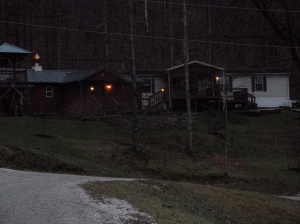
If I may switch topics, this season after Nativity is one in which I have learned to start preparing for Forgiveness Sunday, the first Sunday of Lent. The week after our first Forgiveness Sunday 5 years ago left me a wasted lump of jello, barely able to move without excruciating leg soreness. This was after about 20 prostrations in front of our dear fellow-parishioners. I love this service as I usually feel I am failing my fellow man miserably, and it is a chance to wipe the slate clean. But since then, I've started trying to condition myself before this yearly event. However, I guess it was three years ago last fall, I came down with a terrible back spasm that left me bedridden for a week, barely able to move at all. Since then I've slowly gotten stronger, but still have to be extremely careful how I bend over. I have also favored the way I sit and move around to the point that my lower body, except for standing and walking, is very weak. I think the injury was due to unprepared lifting of heavy patients during my young adult years as a nurse. Maybe my back was also weakened by 4 epidurals during childbirth, and also a particularly stressful time that fall, because I don't remember any other event happening during that time that would have caused it. Anyway, for Christmas George gave our family a new Wii Fit that I have now tried out for the past two days. I can already feel my posture muscles and leg muscles getting stronger, and I am letting myself bend laterally for the first time in a while, as I've had to balance myself vertically to avoid back pain. The exercises are very slow and gentle and while strenuous, they are not too daunting. It's amazing how much a balance sensor in the "step" can diagnose your posture and keep you in a more healthy zone. About 10 years ago I used to do aerobics at a public location and haven't gone back, recently because of the strenuous pace you usually have to adopt at the beginning, but also because it is public and inconvenient. This program however has a very gradual buildup, and after you've achieved a certain measured proficiency you unlock new exercises and more repetitions. It also measures and graphs daily, or however often you work out, weight fluctuations. I am really impressed with how the Wii motivates the whole family to get off the couch with healthy and fun options that are not overtly seductive in nature, as many video games are. I don't really like how they portray the female personal trainer, so I chose the male, but the Wii caricature you make of yourself is shaped more like a peanuts cartoon, and your family members' Mii's participate with you even when they are not physically present. I suppose this contributes to a virtual and non-authentic life, but hopefully being in better shape will lead to something more authentic in the future. So bear with me.
Here's a demo,
[youtube=http://www.youtube.com/watch?v=5oNVIcMnZh4]
We Can Rebuild It
(this post is a few out of sinc)
